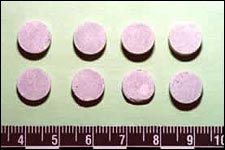|
4-Methylthiomethamphetamine
4-Methylthiomethamphetamine (4-MTMA; code name PAL-1063), also known as ''N''-methyl-4-methylthioamphetamine (NMMTA), is a monoamine releasing agent (MRA) of the amphetamine family related to 4-methylthioamphetamine (4-MTA) and ''N'',''N''-dimethyl-4-methylthioamphetamine (DMMTA or 4-MTDMA). Much less is known about 4-MTMA compared to 4-MTA. 4-MTMA is known to act as a potent serotonin releasing agent (SRA). Its value for induction of serotonin release in rat brain synaptosomes was 21nM, whereas norepinephrine and dopamine release were not reported. In addition to its MRA activity, like 4-MTA, the drug has been found to act as a potent reversible enzyme inhibitor of monoamine oxidase A (MAO-A). It is about one-third as potent as 4-MTA as an MAO-A inhibitor. Its value for MAO-A inhibition is 0.89nM, whereas the values of 4-MTA are 0.13nM for (+)-4-MTA and 2.04nM for (–)-4-MTA. Neither 4-MTA nor 4-MTMA inhibited monoamine oxidase B (MAO-B). Potent monoamine oxidase inhibition ... [...More Info...] [...Related Items...] OR: [Wikipedia] [Google] [Baidu] |
Monoamine Releasing Agent
A monoamine releasing agent (MRA), or simply monoamine releaser, is a drug that induces the release of one or more monoamine neurotransmitters from the presynaptic neuron into the synapse, leading to an increase in the extracellular concentrations of the neurotransmitters and hence enhanced signaling by those neurotransmitters. The monoamine neurotransmitters include serotonin, norepinephrine, and dopamine; MRAs can induce the release of one or more of these neurotransmitters. MRAs work by reversing the direction of the monoamine transporters (MATs), including the serotonin transporter (SERT), norepinephrine transporter (NET), and/or dopamine transporter (DAT), causing them to promote efflux of non-vesicular cytoplasmic monoamine neurotransmitter rather than reuptake of synaptic monoamine neurotransmitter. Many, but not all MRAs, also reverse the direction of the vesicular monoamine transporter 2 (VMAT2), thereby additionally resulting in efflux of vesicular monoamine neuro ... [...More Info...] [...Related Items...] OR: [Wikipedia] [Google] [Baidu] |
4-methylthioamphetamine
4-Methylthioamphetamine (4-MTA), also known as ''para''-methylthioamphetamine (MTA), is a designer drug of the substituted amphetamine class developed in the 1990s by a team led by David E. Nichols, an American pharmacologist and medical chemist, at Purdue University. It acts as a non-neurotoxic highly selective serotonin releasing agent (SSRA) in animals. 4-MTA is the methylthio derivative of amphetamine. History First appearance In 1997, the Forensic Science Laboratory of the Netherlands received reports of three unrelated drug deaths. The substance in question was a new ring-substituted amphetamine derivative. In 1998 two additional cases of this still unknown compound were added to the list, and the incidents were reported to the IPSC (Institut de Police Scientifique et de Criminologie, University of Lausanne, Switzerland). In both the Netherlands and Switzerland, the unknown compound was encountered in the hydrochloride salt form, and pictures of the different tablets we ... [...More Info...] [...Related Items...] OR: [Wikipedia] [Google] [Baidu] |
Para-methoxymethamphetamine
''para''-Methoxymethamphetamine (PMMA), also known as 4-methoxy-''N''-methylamphetamine (4-MMA), is a serotonergic drug of the amphetamine family related to ''para''-methoxyamphetamine (PMA). It is the 4-methoxy analogue of methamphetamine. Little is known about the pharmacological properties, metabolism, and toxicity of PMMA; because of its structural similarity to PMA, which has known toxicity in humans, it is thought to have considerable potential to cause harmful side effects or death in overdose. In the early 2010s, a number of deaths in users of the drug MDMA were linked to misrepresented tablets and capsules of PMMA. PMMA is a serotonin–norepinephrine releasing agent (SNRA) as well as potent monoamine oxidase inhibitor (MAOI). Its effects in humans are reputedly similar to those of PMA, but slightly more empathogenic in nature. It has a reduced tendency to produce severe hyperthermia at low dosages, but at higher dosages side effects and risk of death become similar ... [...More Info...] [...Related Items...] OR: [Wikipedia] [Google] [Baidu] |
Serotonin Releasing Agent
A serotonin releasing agent (SRA) is a type of drug that induces the release of serotonin into the neuronal synaptic cleft. A selective serotonin releasing agent (SSRA) is an SRA with less significant or no efficacy in producing neurotransmitter efflux at other types of monoamine neurons, including dopamine and norepinephrine neurons. SRAs, for instance fenfluramine, dexfenfluramine, and chlorphentermine, have been used clinically as appetite suppressants. However, these SRAs were withdrawn from the market due to toxicity in the 1990s and no SRAs were available or employable for clinical study for many years. In any case, a low-dose formulation was reintroduced for treatment of Dravet syndrome in 2020 and this allowed clinical and research use of SRAs in humans once again. Aside from use as appetite suppressants, SSRAs have been proposed as novel antidepressants and anxiolytics, with the potential for a faster onset of action and superior effectiveness relative to the selectiv ... [...More Info...] [...Related Items...] OR: [Wikipedia] [Google] [Baidu] |
Drug Discrimination
Drug discrimination (DD) is a technique in behavioral neuroscience used to evaluate the discriminative stimulus properties or interoceptive cues of psychoactive drugs. In drug discrimination, a subject is trained on a training drug, and then it is tested with novel drugs to see if the novel drugs are experienced as similar to the training drug. In essence, the drug discrimination paradigm has the subject "tell" the experimenter "I think you gave me the training drug" or "I don't think you gave me anything". The discriminative stimulus properties of drugs are believed to reflect their subjective effects. When partial or full stimulus generalization of a test drug to a training drug occurs, the test drug can be assumed to have effects that are subjectively similar to those of the training drug. Drug discrimination tests are usually performed in animals, but have also been conducted in humans. Drug discrimination assays have been employed to assess whether drugs have stimulant- ... [...More Info...] [...Related Items...] OR: [Wikipedia] [Google] [Baidu] |
Designer Drugs
A designer drug is a structural or functional analog of a controlled substance that has been designed to mimic the pharmacological effects of the original drug, while avoiding classification as illegal and/or detection in standard drug tests. Designer drugs include psychoactive substances that have been designated by the European Union, Australia, and New Zealand, as new psychoactive substances (NPS) as well as analogs of performance-enhancing drugs such as designer steroids. Some of these designer drugs were originally synthesized by academic or industrial researchers in an effort to discover more potent derivatives with fewer side effects and shorter duration (and possibly also because it is easier to apply for patents for new molecules) and were later co-opted for recreational use. Other designer drugs were prepared for the first time in clandestine laboratories. Because the efficacy and safety of these substances have not been thoroughly evaluated in animal and human tr ... [...More Info...] [...Related Items...] OR: [Wikipedia] [Google] [Baidu] |
Drug Of Misuse
Substance misuse, also known as drug misuse or, in older vernacular, substance abuse, is the use of a drug in amounts or by methods that are harmful to the individual or others. It is a form of substance-related disorder, differing definitions of drug misuse are used in public health, medical, and criminal justice contexts. In some cases, criminal or anti-social behavior occurs when some persons are under the influence of a drug, and may result in long-term personality changes in individuals which may also occur. In addition to possible physical, social, and psychological harm, the use of some drugs may also lead to criminal penalties, although these vary widely depending on the local jurisdiction.. Drugs most often associated with this term include alcohol (drug), alcohol, Substituted amphetamine, amphetamines, barbiturates, benzodiazepines, cannabis (drug), cannabis, cocaine, hallucinogens, methaqualone, and opioids. The exact cause of substance abuse is sometimes clear, bu ... [...More Info...] [...Related Items...] OR: [Wikipedia] [Google] [Baidu] |


